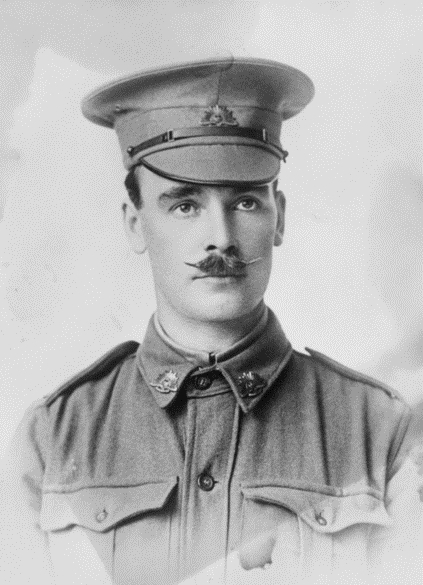Pte
Charles Henry Knight
Informationen zu Geburt
|
Geburtsdatum: 09/08/1883 |
|
Geburtsort: Hailsham, Sussex, England, Vereinigtes Königreich |
Allgemeine Informationen
|
Beruf: Lagerverwalter und Vertreter für J. Bell & |
Informationen zum Armeedienst
|
Land: Australia |
|
Truppe: Australian Imperial Force |
|
Rang: Private |
|
Dienstnummer: 7259 |
|
Einberufung datum: 15/09/1916 |
|
Einberufung ort: Blackboy Hill, Western Australia, Australia |
|
Einheiten: — Australian Infantry, 16th Bn. (Letzte bekannte Einheit) |
Informationen zu Tod
|
Sterbedatum: 27/09/1917 |
|
Sterbeort: Albania Woods Zonnebeke, Belgien |
|
Todesursache: Im Kampf gefallen |
|
Alter: 34 |
Gedenkstätte
|
Ypres (Menin Gate) Memorial Tafel: 17D |
Auszeichnungen und Orden 2
|
British War Medal Medaille |
|
Victory Medal Medaille |
Punkte von Interesse 3
| #1 | Geburtsort | ||
| #2 | Einberufung ort | ||
| #3 | Ort des Todes (ungefähr) |
Meine Geschichte
Private Charles Henry Knight served in the 16th Battalion Australian Infantry part of the 4th Australian Brigade, of the 4th Australian Division. The Division participated in the Battle of Polygon Wood a stage of the Third Battle of Ypres.
On the 23rd of September, the 4th Australian Bde., moved to the front and made the final preparations for the attack on the 26th. During the night of the 25th they silently settled at their jumping off positions between the hamlet of Westhoek and Albania Woods. The 26th of September marks the start of the Battle of Polygon Wood.
The 4th Australian Division attacked with the 13th Bde. on the left and the 4th Australian Bde. on the right, almost directly positioned near the north edge of Polygon Wood. The 4th Australian Bde. attacked with the 13th Australian Battalion ( in support ), the 14th and 15th Australian Battalion ( responsible for the second objective, the so-called Blue Line ) and the 16th Australian Battalion ( responsible for the first objective, the Red Line (J.4.a.6.3. – J.4.c.8.3.), roughly running from Jabber House to the Cemetery, now CWGC Polygon Wood Cemetery).
The attack commenced at 5.50 a.m. with an opening barrage. The 16th Battalion took the lead. Just an hour after the beginning of the attack, the 16th Battalion reached and consolidated the Red Line, this while having suffered slight casualties. The 14th and 15th Battalion went through the 16th and advanced to the next objective, which they gained and consolidated around 7.30 a.m. At 3 p.m. the Germans were seen at approximately 100yards of the new British front line. A counter attack was fend off with artillery.
During the night, the 16th Battalion was sent to relieve the 13th Battalion at the old front line near Westhoek, where they occupied the new support lines and were engaged in working parties. Private Knight was killed on the 27th of September. He possibly fell due to German shelling while the 16th Battalion was holding the support near Albania Woods or while being engaged in a working party. Private Charles Henry Knight’s remains were never found or were never identified. He is remembered on the (Ypres) Menin Gate Memorial.
On the 23rd of September, the 4th Australian Bde., moved to the front and made the final preparations for the attack on the 26th. During the night of the 25th they silently settled at their jumping off positions between the hamlet of Westhoek and Albania Woods. The 26th of September marks the start of the Battle of Polygon Wood.
The 4th Australian Division attacked with the 13th Bde. on the left and the 4th Australian Bde. on the right, almost directly positioned near the north edge of Polygon Wood. The 4th Australian Bde. attacked with the 13th Australian Battalion ( in support ), the 14th and 15th Australian Battalion ( responsible for the second objective, the so-called Blue Line ) and the 16th Australian Battalion ( responsible for the first objective, the Red Line (J.4.a.6.3. – J.4.c.8.3.), roughly running from Jabber House to the Cemetery, now CWGC Polygon Wood Cemetery).
The attack commenced at 5.50 a.m. with an opening barrage. The 16th Battalion took the lead. Just an hour after the beginning of the attack, the 16th Battalion reached and consolidated the Red Line, this while having suffered slight casualties. The 14th and 15th Battalion went through the 16th and advanced to the next objective, which they gained and consolidated around 7.30 a.m. At 3 p.m. the Germans were seen at approximately 100yards of the new British front line. A counter attack was fend off with artillery.
During the night, the 16th Battalion was sent to relieve the 13th Battalion at the old front line near Westhoek, where they occupied the new support lines and were engaged in working parties. Private Knight was killed on the 27th of September. He possibly fell due to German shelling while the 16th Battalion was holding the support near Albania Woods or while being engaged in a working party. Private Charles Henry Knight’s remains were never found or were never identified. He is remembered on the (Ypres) Menin Gate Memorial.
Quellen 4
|
16th Australian Infantry Battalion, (Australian War Memorial, Campbell (AWM), AWM4 23/33/22). https://www.awm.gov.au/collection/C1338583 Verwendete Quellen |
|
Longmore C., The Old Sixteenth. Being the story of the 16th Battalion A.I.F. during the Great War of 1914-1918 , (Carlisle, Hesperian Press, 2007), pg. 148 - 150. Verwendete Quellen |
|
McCarthy C., The Third Ypres Passchendaele. The Day-by-Day Account, (London, Arms & Armour Press, 1995), pg. 87-89. Verwendete Quellen |
|
Roll of Honour https://www.awm.gov.au/people/rolls/R1639880/ Verwendete Quellen |
Weitere Informationen 4
|
Commonwealth War Graves Commission Database https://www.cwgc.org/find-records/find-war-dead/casualty-details/924742 |
|
Namenlijst (In Flanders Fields Museum) https://namenlijst.org/publicsearch/#/person/_id=1f61882e-f853-455f-b9f7-83fe7adff9bd |
|
Lives of the First World War (Imperial War Museum) https://livesofthefirstworldwar.iwm.org.uk/lifestory/7506117 |
|
The AIF Project (UNSW Canberra) https://aif.adfa.edu.au/showPerson?pid=167324 |
